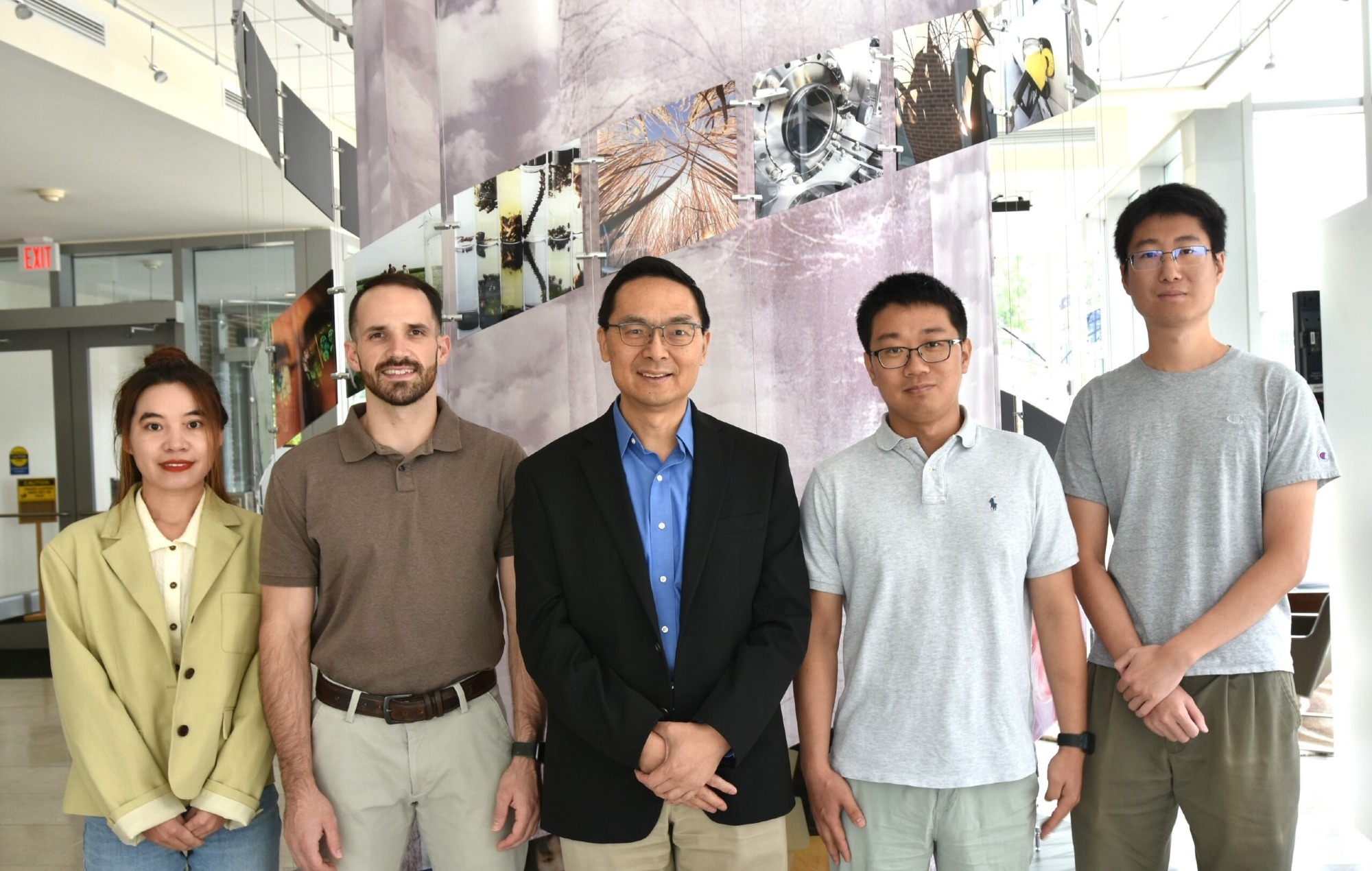A team of pioneering scientists from the Center for Advanced Bioenergy and Bioproducts Innovation (CABBI) has a noteworthy breakthrough in the intricate realm of molecular chemistry.

The research team, from left: Postdoc Yujie Yuan, Ph.D. Candidate Wesley Harrison, CABBI Conversion Theme Leader Huimin Zhao, Postdoc Maolin Li, and Postdoc Zhengyi Zhang. Image Credit: Julie Wurth/CABBI Communications
The researchers at the Center for Advanced Bioenergy and Bioproducts Innovation (CABBI) have uncovered unique molecular puzzle pieces that play a crucial role in the production of a variety of everyday products, ranging from eco-friendly agrochemicals to essential medicines.
Their demonstration of an innovative method to modify these molecules represents a groundbreaking discovery with significant implications for the development of new industrially relevant chemical reactions and also suggests potential applications in sustainable energy solutions.
At the core of their investigations lies the utilization of photo enzymatic systems. It is comparable to enhancing the capabilities of enzymes, nature’s miniature laborers, by providing them with a metaphorical flashlight.
This process empowers enzymes to construct or mend molecular structures in ways that are earlier unparalleled. Through the utilization of light energy, these researchers have discovered innovative chemical reactions that were once deemed unattainable.
The study, published in Nature Chemistry, is accompanied by scientists from the University of Illinois Urbana-Champaign. The lead authors are CABBI Conversion Theme Leader Huimin Zhao, Professor of Chemical and Biomolecular Engineering (ChBE), biosystems design theme leader of the Carl R. Woese Institute for Genomic Biology (IGB), and Director of the NSF Molecule Maker Lab Institute at Illinois. Maolin Li is also a Postdoctoral Research Associate with CABBI, ChBE, and IGB.
The team’s creation of an ene-reductase system, a specialized molecular toolkit utilizing the ene-reductase enzyme, represents a significant achievement. This molecular toolkit, previously employed in Zhao's lab for other studies, has provided researchers with a method to intricately modify molecules without causing unintended collateral damage.
The important realization of their work is grasping the enantioselective hydrogen atom transfer. Molecules often come in left- and right-handed versions, or enantiomers, similar to gloves. The team’s method enables us to particularly target and alter either version with unparalleled precision. Precise adjustments can be made from a distance through remote stereo control.
The discovery made by CABBI and its researchers stands as a game-changer for both the center and the bioenergy sector at large. Biofuels and bioproducts, which involve deriving energy and products from plant material rather than non-renewable sources like petroleum, signify a more environmentally friendly and sustainable future.
The group's breakthrough has significantly broadened the scope of chemical reactions and bioproducts that can be efficiently produced.
With our novel approach to azaarenes and the use of enzymatic hydrogen atom transfer, we’re not just pushing boundaries in chemistry. We’re laying down the foundations for a more sustainable and innovative future. Our research has broadened the toolkit available for eco-friendly production and has the potential to catalyze breakthroughs in agrochemicals and beyond.
Huimin Zhao, Professor, Center for Advanced Bioenergy and Bioproducts Innovation, University of Illinois
Development in bioenergy and bioproducts can lead to economic growth, with new industries, jobs, and products for consumers and potentially more affordable energy sources. The possibility for real-world applications is huge beyond the lab, from leading the charge in sustainable energy to spearheading safer agricultural chemicals. The research decreases pollution and environmental degradation by stimulating sustainable and efficient production methods, resulting in cleaner air and water for communities.
As the world grapples with environmental challenges and the pressing need for sustainable solutions, discoveries like these light the way forward. As a postdoctoral researcher on this project, I’ve been deeply immersed in the intricacies of azaarenes and their potential. Unraveling the challenges of remote stereo control and witnessing the transformative possibilities of our findings has been truly exhilarating. This research isn’t just about the nuances of chemical reactions; it’s about the future of sustainable energy and more. I’m excited to see where this journey takes us next.
Maolin Li, Author, Center for Advanced Bioenergy and Bioproducts Innovation, University of Illinois
Co-authors of the study included Ph.D. candidate Wesley Harrison and Postdoctoral Researchers Yujie Yuan and Zhengyi Zhang of CABBI, ChBE, and IGB.
Journal Reference
Li, M., et al. (2023). Remote stereocontrol with azaarenes via enzymatic hydrogen atom transfer. Nature Chemistry. doi/s41557-023-01368-x.